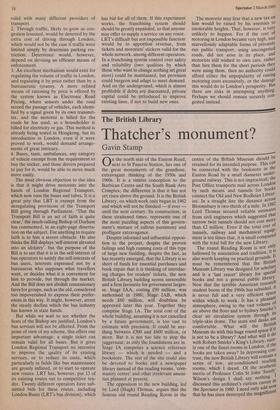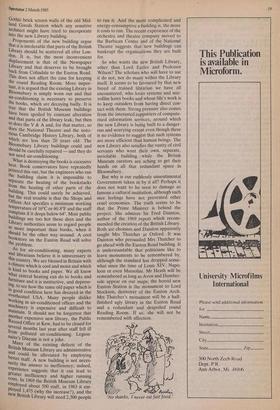The British Library
Thatcher's monument?
Gavin Stamp
n the north side of the Euston Road, next to St Pancras Station, lies one of the great monuments of the grandiose, extravagant thinking of the 1950s and 1960s. It is a similar conception to the Barbican Centre and the South Bank Arts Complex; the difference is that it has not yet risen above the ground. It is the British Library, on which work only began in 1982 and which will not be finished — if ever — until the next century. Its construction, in these straitened times, represents one of the most puzzling aspects of this govern- ment's mixture of callous parsimony and profligate extravagance.
Despite informed and influential opposi- tion to the project, despite the proven failings and high running costs of this type of large new building, despite the fact, as has recently emerged, that the Library is so short of funds for essential purchases and book repair that it is thinking of introduc- ing charges for readers' tickets, the new British Library. building seems inexorable and a firm favourite for government larges- se. Stage IAA, costing £90 million, was authorised in 1980; Stage IAB, which needs £60 million, will doubtless be approved later this year. Together they comprise Stage 1A. The total cost of the whole building, assuming it is not cancelled by a future government, is too vast to estimate with precision. It could be any- thing between £300 and £600 million, or more. But it is not too late to stop the juggernaut, as only the foundations are in. Stage IA comprises a science reference library — which is needed — and a bookstore. The rest of the site could also be devoted to books and a newspaper library instead of the reading rooms, 'com- munity centre' and other irrelevant ameni- ties planned at present.
The opposition to the new building, led by Lord (Hugh) Thomas, argues that the famous old round Reading Room in the
centre of the British Museum should be retained for its intended purpose. This can be connected with the bookstore in the Euston Road by a small diameter under- ground railway. This is not impractical; the Post Office transports mail across London by such means and tunnels for books connect the Old and New Bodleian Librar- ies. In a straight line the distance across Bloomsbury is two-thirds of a mile. In 1982 Lord Thomas secured reliable estimates from civil engineers which suggested that narrow twin tunnels should not cost more than £2 million. Even if the total cost .of tunnels, railway and mechanical equll)". ment is ten times that, it is small compared with the total bill for the new Library. The round Reading Room is not only hallowed by association and tradition, it is also worth keeping on practical grounds.. It must be remembered that the British Museum Library was designed for schola.rs, and is a 'last resort' library for special books and not a general public library. Now that the terrible American researc.h student boom of the 1960s has subsided, it is never full and a very efficient space within which to work. It has a pleasant atmosphere, owing to the vast volume (1)! air above the floor and to Sydney Smirke. s clear air circulation system through its triple-skin dome. The seats and desks. a.re comfortable. What will the Brit.' Museum do with this huge round space if it is not to be a library? And what will it do with Robert Smirke's King's Library, sure- ly one of the finest rooms in London, if the books are taken away? In depressing con- trast, the new British Library will contain a series of low, air-conditioned readin.g rooms, which I dread. Of the aesthetic merits of Professor Colin St John `Sandy Wilson's design I shall say nothing. I discussed this architect's curious career 10 the Spectator in 1980. I need only add. now that he has since destroyed the magnificent Gothic brick screen walls of the old Mid- land Goods Station which any sensitive architect might have tried to incorporate Into the new Library building. Proponents of the new building argue that it is intolerable that parts of the British Library should be scattered all over Lon- don. It is, but the most inconvenient displacement is that of the Newspaper Library and that deserves to be brought back from Colindale to the Euston Road. This does not affect the case for keeping the round Reading Room. More impor- tant, it is argued that the existing Library in Bloomsbury is simply worn out and that air-conditioning is necessary to preserve the books, which are decaying badly. It is true that the British Museum buildings have been spoiled by constant alteration and that parts of the library leak, but then SO does the V & A and, for that matter, so does the National Theatre and the noto- nous Cambridge History Library, both of Which are less than 20 years old. The Bloomsbury Library buildings could and Should be carefully repaired — and they do not need air-conditioning. What is destroying the books is excessive heat. Book conservators have repeatedly Pointed this out, but the engineers who run the building claim it is impossible to separate the heating of the bookstacks from the heating of other parts of the building. This could surely be achieved, but the real trouble is that the Shops and Offices Act specifies a minimum working temperature of 16°C or 60.8°F and the staff Complain if it drops below 64°. Most public buildings are too hot these days and the Library authorities seem to regard people as more important than books, when it should be the other way around. A cool bookstore on the Euston Road will solve the problem. As for air-conditioning, many experts and librarians believe it is unnecessary in this country. We are blessed in Britain with Climate which is cool and moist and which is kind to books and paper. We all know What central heating can do to books and furniture and it is instructive, and depress- !hg, to see how the same old paper which is in good condition here has decayed in the overheated USA. Many people dislike working in air-conditioned offices and the machinery is expensive and difficult to Maintain. It should not be forgotten that another expensive new library, the Public Record Office at Kew, had to be closed for several months last year after staff fell ill from polluted air-conditioning. Legion- naire's Disease is not a joke. Many of the existing defects of the British Museum Library are administrative and could be alleviated by employing better staff. A new building is not neces- sarily the answer to inefficiency; indeed, experience suggests that it can lead to greater inefficiency and higher running costs. In 1969 the British Museum Library employed about 500 staff, in 1983 it em- ployed 1,475 (why the increase?), and the now British Library will need 2,500 people to run it. And the more complicated and energy-consumptive a building is, the more it costs to run. The recent experience of the orchestra and theatre company moved to the Barbican Centre and of the National Theatre suggests that new buildings can bankrupt the organisations they are built for.
So who wants the new British Library, other than Lord Eccles and Professor Wilson? The scholars who will have to use it do not, nor do many within the Library itself. It seems to be favoured by that new breed of trained librarian we have all encountered, who loves systems and mic- rofilm hates books and whose life's work is to keep outsiders from having direct con- tact with them. Strong pressure also comes from the interested supporters of compute- rised information services, around which the new Library is being built to a danger- ous and worrying extent even though there is no evidence to suggest that such systems are more efficient than human beings. The new Library also satisfies the vanity of civil servants who want their own, separate, inviolable building while the British Museum curators are aching to get their hands on all that redundant space in Bloomsbury.
But why is our ruthlessly unsentimental Government taken in by it all? Perhaps it does not want to be seen to damage so famous a cultural institution, although such nice feelings have not prevented other cruel economies. The truth seems to be that the Prime Minister is behind the project. She admires Sir Fred Dainton, author of the 1969 report which recom- mended the creation of the British Library. Both are chemists and Dainton apparently taught Mrs Thatcher at Oxford. It was Dainton who persuaded Mrs Thatcher to go ahead with the Euston Road building. It is understandable that politicians like to leave monuments to be remembered by, although the standard has dropped some- what since the time of Louis XIV, Napo- leon or even Mussolini. Mr Heath will be remembered as long as Avon and Humber- side appear on our maps; the horrid new Euston Station is the monument to Lord Stockton, destroyer of the Euston Arch. Mrs Thatcher's monument will be a half- finished ugly library in the Euston Road and a redundant and despoiled round Reading Room. If so, she will not be remembered with affection.
No thanks, I never eat fast food.'















































 Previous page
Previous page